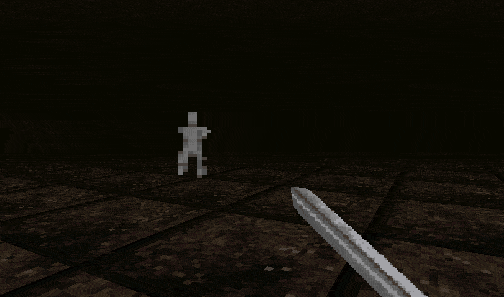For the past few months we have been working on a number of levels. One of the most immediate goals for us is getting the first act laid out in terms of content so we can balance and polish to the point of a playable build that could be potentially released. For this post we wanted to showcase one of these levels – tentatively named ‘The Quarry’. There is still tweaking as well as additional art to implement but the bones are in place and hopefully documenting this stage of development reveals something interesting about our approach and process.
![]()
We needed a level that introduced slaves who can be freed to fight alongside the player. The obvious answer would have been a prison (which we will probably do at some point) but I wanted to branch out from the corridor focused texture sets we have been using so far. Both of these intentions were met by recalling the slave quarry scene from the opening of Spartacus (1960) – the setting fits thematically, mechanically and offers a new outdoor location that could be achieved within the limitations of our aesthetic.
![]()

The architecture and environment of the quarry is mostly made from rock formations with a theme of wooden scaffolding and makeshift structures throughout. The two main areas are the soldier’s camps and fortifications, the mining pit as well as a cave. Conditions in Roman mines were brutal. Many of these slaves were criminals known as “damnati in metallum” – which translates to “those condemned to the mine”. Other slaves in Rome could earn or purchase their freedom, these slaves however would work until their death.
![]()
In terms of gameplay, this level experiments with having the sling as a primary weapon as well as the gladius. So far we have used the sword as a staple starting point so introducing a ranged weapon with a bit of ammo management adds a bit of variety as well as strategy to the gameplay. The sling’s behavior was tweaked quite a bit to make it viable – running a level with a single weapon seems to be a good test of not just its usability but also fun factor. Currently the sling can be held for a strong shot or tapped for a faster but less damaging throw. This dynamic in addition to the extra damage dealt on surprise attacks makes for some interesting encounters.

![]()
The overall level is fairly linear and so the cave section breaks this structure by offering two seperate paths to take which should keep the level fresh on repeated plays. Both routes have a few pickups as well as allied slaves to free who will fight alongside the player (art is still being developed). An important design consideration was the placement of these benefits; they are far away enough from the fastest route to be of little use to speed runners but are also easy enough to find that players struggling with the level could go both ways to collect all of the slaves and items. This is a thought process throughout the entire game as we want levels to be challenging to speedrun but also provide options for players who want to take the game at a slower pace.

The game is very much a revenge story and so this opening shot of the level sets the tone of the tyranny and brutality of the senators that you are assassinating. Crucifixion was a method of punishment used in Ancient Rome. Mass crucifixions took place throughout Roman history with 6,000 of Spartacus’ followers suffering the torturous death after rebelling. Thematically this scene fits the context of a corrupt slave quarry as well as motivates the player to show little mercy to the ruling senator and his troops.
![]()
This level introduces a dog enemy type who runs quickly towards the player and alerts other units by barking. While not particularly high in health, the dog can be dangerous due to its high speed and potential to cause a chain reaction of opponents closing in on the player. This gif also includes a campfire with a roast leg. One of the great strengths of the Roman military over its opponents was superior nutrition. This versatile prop can be used throughout camp areas and provides a bit of flavour to the environment. I’m sure the dogs would love to sneak a bite!

Something fascinating about making this game using GameMaker is the way in which 2D design sentiments translate to a 3D context. We’ve definitely been inspired by looking at Wolfenstien 3D editor and the intricacies of zoomed out video game maps. There is something very rewarding in laying out disgusting 2D sprites in a flat editor, then hitting ‘play’ and seeing the world come to life. Below is a side by side shot of the Quarry in editor as well as the same view in game through the 3D camera. Some new cinematic debugging features were implemented this week which definitely helps in capturing more dramatic screenshots – it is also quite strange seeing our flat-plane environments form a different angle!
![]()
![]()
That’s all for this post! It will be interesting to see how the level changes going forward as a lot of the balance depends on where it is placed in the game. We probably won’t do a post on every level like this (a little surprise is always good) but expect to see a few more areas being fleshed out in the coming months. If you would like to talk about the game, head over to our TIG Devlog.
Bonus content: Have you ever wondered how many stone quarries were in Ancient Rome? Have you ever wished you had a tabulated database and location map? Well, during research for this stage we found this great paper. Ben Russell has your back.



















